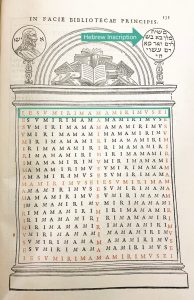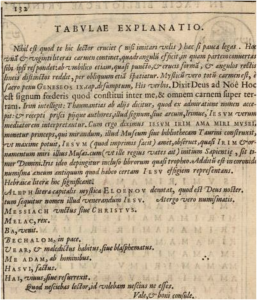This past week, Pitts librarians embarked on a research blitz to explain an image found in one of our rare books. Pitts owns a first edition of a 1577 history of the Italian city of Turin, written by Emanuele Filiberto Pingone (1525-1582). The book is richly illustrated with images depicting the history of the city and explaining its features and origins. One particularly interesting image (shown here) features Jesus, a stack of books, a Hebrew inscription, and a long Latin palindrome. The Pitts team worked quickly to decipher all that’s going on in this fascinating image. Reference and Instruction Librarian Brady Beard and Head of Cataloging Armin Siedlecki focused on translating the Hebrew inscription at the top right, which is clearly abbreviated and thus difficult to render. Consensus arose that the inscription seems to say something like “Messiah, King who came in shame, the exalted one and great light, who brings life,” but not all the letters and words fit into a clean translation.

Cataloging and Metadata Librarian Brinna Michael (with help from her sister Kelin, who is a PhD candidate in Emory’s Art History Department) took on the palindrome in Latin at the center of the image, which repeats the phrase IESVM IRIM AMA MIRI MVSEI. They were puzzled by parts of the phrase, particularly by the word IRIM, which is either related to hedgehogs or the Greek goddess Iris, both of which seemed odd in the context of the image. After significant research, including reading the Latin explanatory notes on the following pages of the work, Brinna pieced together the mystery. She reports, “It’s using ‘irim’ as an epithet for Jesus in the sense that, like Iris was the messenger of the Greek gods, Jesus is the messenger of God on Earth (also the explanation mentions that the rainbow was given to Noah as a sign of the covenant between God and earth in Genesis IX). On top of that, the inscription is saying ‘Love Jesus as Iris of the wondrous [place of] the Muses’ (aka a library or museum), hence the rainbow and books in the imagery at the top. The notes also mention ‘the origin of wisdom/knowledge being in the fear of God.’ All to say, this is saying that the library/museum in Turin is great, but remember to love Jesus because he’s the reason it’s all there.”
 In addition to Brinna’s explanation of the Latin palindrome, which makes sense of all the elements in the image as well as its placement within the work, she notes that the following pages also include an explanation of the Hebrew letters used in the top right inscription. These explanatory notes confirm the basic meaning deciphered by Armin and Brady, but shed new light on some confusing elements by identifying abbreviations used in the message (see the image of these notes). For example, instead of reading the Hebrew word B-sh in the inscription as “shame” (which was a bit odd as a grammatical construction), the notes identify these characters as the beginning of the word B-shalom, with continues on the next line of the inscription. Therefore, the proper translation is “Messiah, King, who comes in peace and creates life from the sin of Adam (or humanity).”
In addition to Brinna’s explanation of the Latin palindrome, which makes sense of all the elements in the image as well as its placement within the work, she notes that the following pages also include an explanation of the Hebrew letters used in the top right inscription. These explanatory notes confirm the basic meaning deciphered by Armin and Brady, but shed new light on some confusing elements by identifying abbreviations used in the message (see the image of these notes). For example, instead of reading the Hebrew word B-sh in the inscription as “shame” (which was a bit odd as a grammatical construction), the notes identify these characters as the beginning of the word B-shalom, with continues on the next line of the inscription. Therefore, the proper translation is “Messiah, King, who comes in peace and creates life from the sin of Adam (or humanity).”
This research adventure has led to updates in the description of the image in Pitts’ Digital Image Archive (http://pitts.emory.edu/dia), the home of over 65,000 images like this one, digitized from Pitts’ rare book collection. It was also a clear demonstration of the impressive talent and infectious energy on the Pitts staff. Thanks to Brinna, Brady, Armin (and Kelin!) for their work on this. I suspect there may be more research to be done on this interesting book (so let us know if you want to join in the fun)!
Content by Richard (Bo) Manly Adams, Jr., Director of the Library
